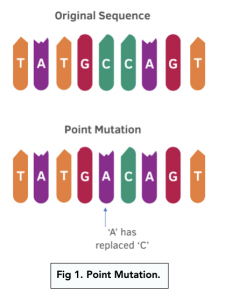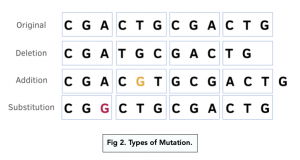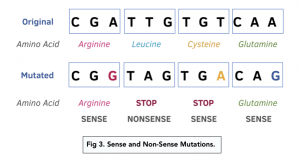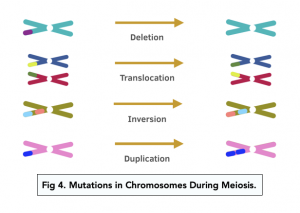Chromosome Mutations (A-level Biology)
Chromosome Mutations
Gene Mutations
Gene mutations involve a change in the base sequence of chromosomes.
- Gene mutations usually happen due to replication errors. Polymerases responsible for replicating the DNA can sometime make errors called “proof reading” errors, where they mistakenly add or remove a base.
- Mutations in a single base of DNA are called point mutations. Point mutations can be either the deletion of a single base, or the gain of a single incorrect base.

There are different types of mutations:
- Base pair deletions: One or more bases are incorrectly deleted from the sequence.
- Base pair substitution: One or more bases are incorrectly replaced with another base(s).
- Base pair insertion/addition: One or more bases are incorrectly added to the sequence.

Frameshift Mutations (Insertion or Deletion)
- Base deletion or insertion can lead to frameshifts. If you add or remove a base from the sequence, all of the bases move up or down. Therefore all of the codons change, which can have a drastic effect on how the gene is read.
Sense and Non-Sense Mutations (Substitution)
- Base substitutions only affect one codon. Point mutations involving base substitution can only affect the sequence of a single codon. The rest of the base sequence remains unaffected.
Sense Mutations
- Sense mutations code for an amino acid. In sense mutations, the codon changes but an amino acid is still produced. The amino acid can be the same or may be a different one.
- Mutations in the third base of a codon may have little effect. Codons are triplets of bases in DNA. A mutation in the third base of a codon usually does not change the amino acid that needs to be encoded. In most cases as long as the first two bases of a codon are correct, the codon will still code for the correct amino acid even if the third base of the codon is incorrect. This is because of the degenerate nature of codons (this effect is also referred to as the 3’ wobble).
Non-Sense Mutations
- Non-sense mutations do not produce an amino acid. In non-sense mutations, usually a STOP codon is coded for, which leads to the production of a truncated (shortened) protein. Alternatively, there could be a significant change in the amino acid sequence of a protein.

Good and Bad Mutations
- Mutations are usually bad for a cell. In most cases, non-sense mutations can result in severe consequences for a cell. Mutations can result in the production of dysfunctional proteins which can have adverse effects on a cell and can sometimes even be lethal.
- Some mutations are beneficial. In some cases, mutations can lead to the development of new alleles of a gene (e.g., mutations causing different eye colours) which can contribute to genetic diversity in a gene pool. Mutations can help in natural selection in particular.
Mutagenic Agents
- Mutagenic agents can increase the rate of gene mutations. Mutagenic agents are chemical, biological or physical agents that cause changes to the DNA of cell. Examples of mutagenic agents include ionising radiation (like X-rays and gamma rays), viruses such as the Human Papilloma Virus (HPV) and chemicals such as formaldehyde and benzene.
Chromosomal Mutations
- Mutations can occur in entire chromosomes. Mutations in chromosomes usually occur in cell division during meiosis. This usually occurs due to improper separation of chromosomes during division, or during improper chromosome recombination.
Breakage of Chromosomes
Breakage of chromosomes during meiosis can result in:
- Deletion: this occurs when an entire region of a chromosome is accidentally deleted.
- Translocation: a portion of one chromosome accidentally switches places with a separate, non-homologous chromosome (e.g. Philadelphia Chromosome).
- Inversion: a portion of a chromosome can break, and re-join into the original chromosome but after inverting itself, resulting in a change in sequence.
- Duplication: regions in a chromosome can become duplicated.

Chromosomes are long strands of DNA that contain genetic information and are present in the nucleus of every cell in the body.
Mutations are changes in the DNA sequence that can alter the genetic information carried by a chromosome.
The different types of chromosome mutations include changes in chromosome number, changes in chromosome structure, and changes in the DNA sequence.
A chromosome deletion is a type of chromosome mutation in which a part of a chromosome is missing. This can result in a loss of genetic information and can cause various genetic disorders.
A chromosome duplication is a type of chromosome mutation in which an extra copy of a chromosome or a segment of a chromosome is present. This can result in an excess of genetic information and can cause various genetic disorders.
A chromosomal inversion is a type of chromosome mutation in which a segment of a chromosome is reversed. This can alter the genetic information and can cause various genetic disorders.
A chromosomal translocation is a type of chromosome mutation in which a segment of one chromosome is transferred to another chromosome. This can alter the genetic information and can cause various genetic disorders.
A point mutation is a type of chromosome mutation in which a single nucleotide in the DNA sequence is altered. This can result in changes in the genetic information and can cause various genetic disorders.
Chromosome mutations can occur due to errors during DNA replication or due to exposure to mutagenic agents such as chemicals or radiation.
The consequences of chromosome mutations can vary depending on the type and location of the mutation. Some mutations can have no effect, while others can cause genetic disorders or increase the risk of cancer.






Still got a question? Leave a comment
Leave a comment